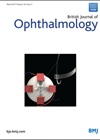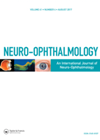
Journal Reviews archive for February 2018
Comparison of corneal deformation parameters in keratoconic and normal eyes
This study set out to compare biomechanical properties between normal and keratoconic eyes. It was a retrospective study evaluating 89 eyes (47 normal, 42 keratoconic) and a validation arm of 72 eyes (33 normal, 39 keratoconic) using a high speed...
Is it worth performing cataract surgery in amblyopic eyes?
It was estimated that about 3% of all cataract surgeries in adults were performed in eyes that have pre-existing amblyopia, and there is a long-standing belief that eyes with amblyopia have limited benefit from cataract extraction in the adult age....
Self refracting – child’s play?
Uncorrected refractive error was the leading cause of vision impairment in the world in 2010. Although refractive error may be safely and effectively corrected with spectacles, lack of well-trained refractionists in settings of limited resources may be a major barrier....
Topography-guided photorefractive keratectomy in the treatment of corneal scarring
This study reports the outcome of topography-guided photorefractive keratectomy (TG-PRK) in the treatment of patients with corneal scarring. A retrospective case series including six eyes of six patients with corneal scarring and irregular astigmatism who underwent topography guided PRK. The...
DMEK versus DSAEK
This systematic review and meta-analysis reviewed published evidence comparing two endothelial corneal transplants techniques; Descemet membrane endothelial keratoplasty (DMEK) and Descemet stripping automated endothelial keratoplasty (DSEAK). DMEK involves transplanting Descemet membrane with endothelial cells without any overlying stroma. In DSAEK...
Topical insulin for neurotrophic ulcers
This retrospective case series described the use of topical insulin drops as an aid in treatment of refractory neurotrophic corneal ulceration in six patients. Insulin drops were prepared under sterile conditions from standard insulin preparations mixed with artificial tears containing...
Treatment of severe chronic ocular graft-versus-host disease
A retrospective study from Cologne, Germany, between November 2012 to March 2015, of 17 patients with graft-versus-host disease (GVHD) treated with 100% single use vials autologous serum eye drops in sealed system. Visual acuity, corneal staining, frequency of artificial tears,...
Ocular surface in donor eyes after CLAU
This retrospective study examined ocular surface stability of donor eyes following conjunctival limbal autografts (CLAU). Forty-five eyes underwent CLAU with chemical burns being the most common indication. All but two eyes had just over 4 o’clock hours of CLAU segment...
DIY IOP – does it work?
Measuring intraocular pressure (IOP) plays a major role in glaucoma care as IOP is a parameter, along with visual field progression and optic disc cupping used to assess treatment effect. While Goldmann tonometry (GAT) is the gold standard, it only...
A comparison of colour vision tests in the presence of contrast sensitivity loss
This study analyses the effect of contrast sensitivity (CS) loss on colour vision (CV) testing, using a variety of colour vision tests. The authors used a computer model for CS loss to determine its effect on CV testing scores for...
Unexplained vision loss following exposure to combat
Non-organic vision loss (NOVL) is defined as a decrease in visual acuity or visual field without an identifiable organic cause. NOVL can be particularly challenging and time-consuming to diagnose, especially where the vision loss is superimposed on an element of...
Orbital abscess following posterior subtenon steroid injection
The authors report a case of orbital cellulitis following posterior subtenon injection of triamcinolone acetonide. A 57-year-old male patient with a background of complicated cataract surgery underwent vitrectomy with explantation of dislocated intraocular lens and insertion of anterior chamber lens....










